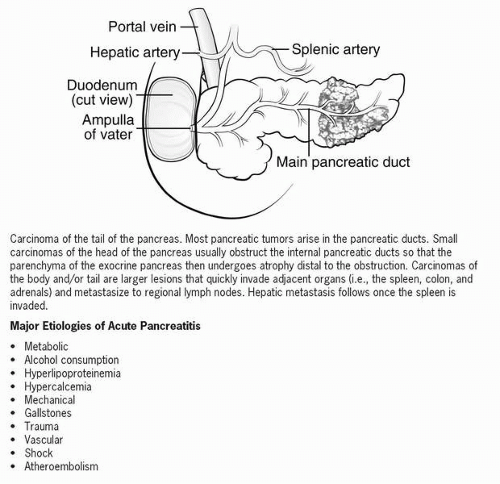Pancreas and Gallbladder Diseases
The functions of the pancreas and gallbladder are closely related. The gallbladder secretes bile; the pancreas secretes enzymes that aid in digestion. When one organ is not functioning optimally, it is not uncommon for it to affect the other organ.
Table 56-1 Causes of Pancreatitis | |||||||
|---|---|---|---|---|---|---|---|
|
Pancreatitis is a self-limiting inflammation of the pancreas with spontaneous regression in 3-7 days. It is more common in men than in women and usually occurs after age 40. It may be acute or chronic and has a high correlation with alcoholism and biliary tract abnormalities.
Pathophysiology
Specific enzymes are needed for digestion and help provide optimal gastric pH. Gastric acid stimulates secretion of secretin, an enzyme necessary for stimulation of pancreatic juice. Cholecystokinin is secreted from the duodenum and jejunum and is triggered by long-chain fatty acids. It is controlled by the parasympathetic nervous system.
The leading cause of acute pancreatitis is a gallstone (>6.5 mm diameter) causing an obstruction of the pancreatic duct at its entrance to the duodenum. As the common bile duct and the common pancreatic duct enter into the duodenum through a common channel (the ampulla of Vater), a stone lodged in the ampulla causes pancreatic juices to back up. Eventually, the pressure in the pancreatic ducts results in their rupture, and pancreatic enzymes leak into the surrounding pancreatic tissues. The enzymes cause autodigestion, inflammation, edema, and necrosis of pancreatic cells.
 The leading cause of acute pancreatitis is a gallstone (>6.5 mm diameter) causing an obstruction of the pancreatic duct at its entrance to the duodenum.
The leading cause of acute pancreatitis is a gallstone (>6.5 mm diameter) causing an obstruction of the pancreatic duct at its entrance to the duodenum.A second cause is excessive alcohol consumption. Alcohol forms plugs in the pancreatic ducts, causing edema and spasm of the pancreatic sphincter in the ampulla of Vater. It also activates the release of
proteolytic enzymes. The obstruction of the duct and the excessive production of enzymes have the same result as above. Together, gallstones and alcohol account for about 80% of acute pancreatic attacks. Other causes include infection, hyperlipidemia, trauma, an idiosyncratic reaction to drugs, and heredity.
proteolytic enzymes. The obstruction of the duct and the excessive production of enzymes have the same result as above. Together, gallstones and alcohol account for about 80% of acute pancreatic attacks. Other causes include infection, hyperlipidemia, trauma, an idiosyncratic reaction to drugs, and heredity.
 Eighty percent of patients with chronic pancreatitis are alcoholics, but only 5% to 10% of alcoholics develop chronic pancreatitis.
Eighty percent of patients with chronic pancreatitis are alcoholics, but only 5% to 10% of alcoholics develop chronic pancreatitis.Stay updated, free articles. Join our Telegram channel

Full access? Get Clinical Tree


Get Clinical Tree app for offline access

